
Patent protection submission: a new method to install flow refuges
One of the outputs of EcoPeak4Fish was a method to install a flow refuge downstream of hydropower plants aiming to protect fish from being displaced downstream when hydropower plants are operating in hydropeaking.


Contribution of EcoPeak4Fish to the new Book “Role of Dams and Reservoirs in a Successful Energy Transition”
The paper “Can hydropeaking by small hydropower plants affect fish microhabitat use?” authored by the EcoPeak4Fish team,
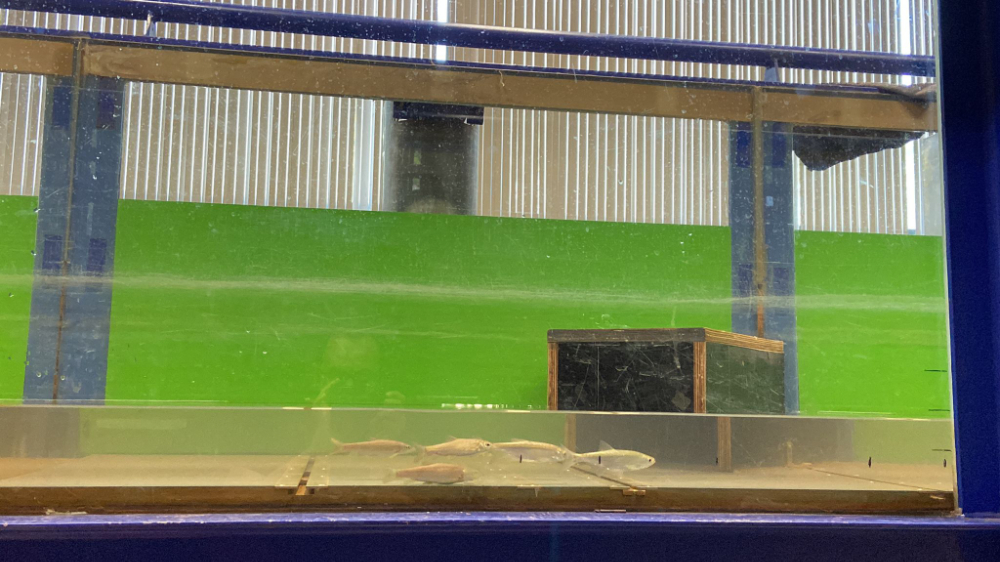
The importance of insertion angle to attracting Iberian barbels to a refuge
The results from the extensive set of flume experiments show that the approaching angle drives effective flow refuge use by fish.

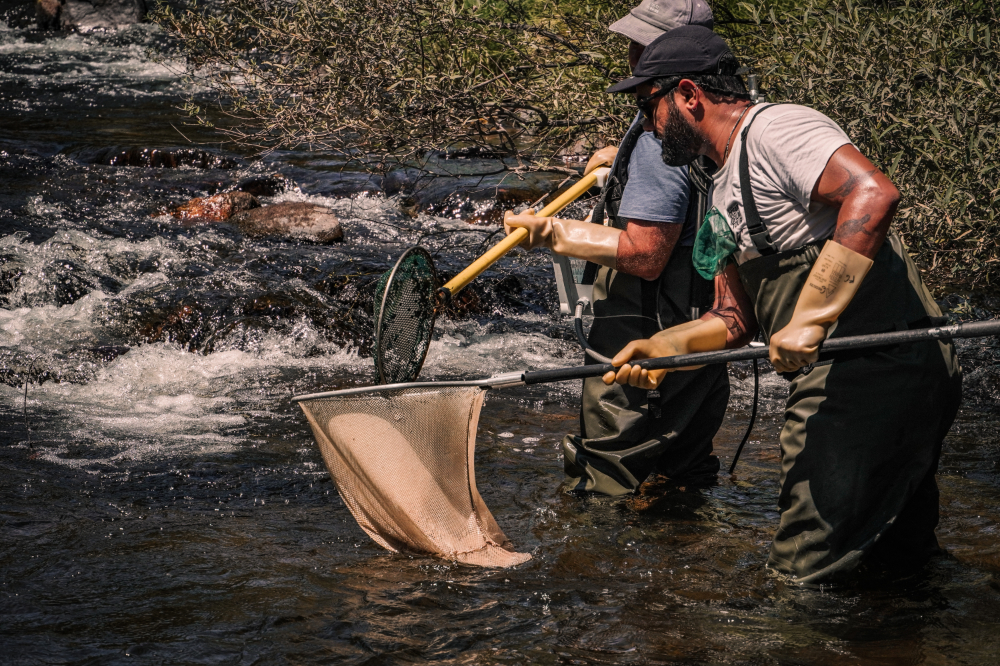
Renan Leite talks about his experience as a PhD candidate within EcoPeak4Fish
Renan Leite collaborates with EcoPeak4Fish as a very motivated PhD candidate.
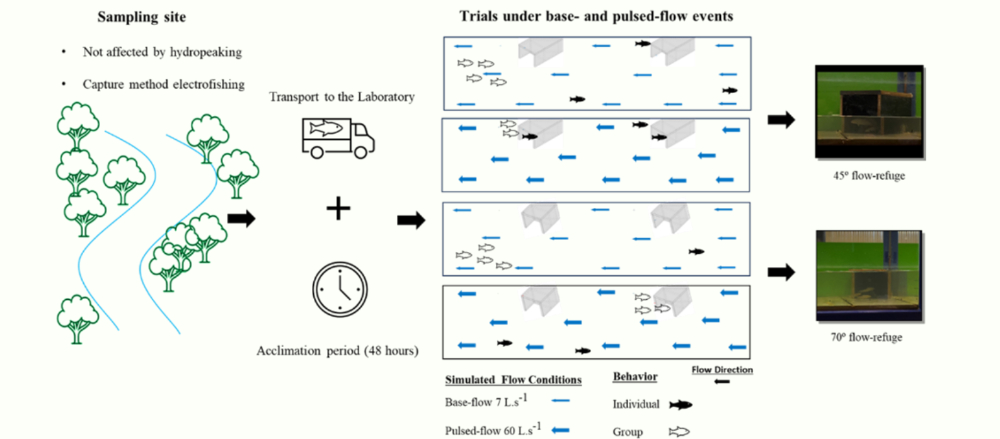
Have you had a chance to explore our latest infosheet?
As part of our ongoing project, we have been releasing informative sheets containing details about various project aspects and outputs from different tasks.


Save the date!
The closing session of EcoPeak4Fish will be held on the 02nd of April 2024 at Instituto Superior Técnico, University of Lisbon.

Patent protection submission: a new method to install flow refuges
One of the outputs of EcoPeak4Fish was a method to install a flow refuge downstream of hydropower plants aiming to protect fish from being displaced downstream when hydropower plants are operating in hydropeaking. This method is a result of an extensive set of experiments conducted at our indoor flume (6.5 m long) at the Laboratory of Hydraulics at Instituto Superior Técnico where we have tested the effectiveness of different insertion angles of flow refuges to attract fish during peak flows.
This successful method to install a flow refuge has been recently submitted to patent protection (PT 118955), with the support of the Technology Transfer Office of Instituto Superior Técnico from the University of Lisbon.
The method involves placing the flow refuge at the bottom of a river bed with its entrance oriented downstream, forming an angle between approximately 40° and 50° with the water current line. The flow refuge, constructed with composite materials, is especially advantageous for use in rivers, which are subject to both wet and dry environments. It also allows for the modular construction of refuges in different sizes, starting from the unit with a 0.50m opening, 0.35m height, and 0.40m depth, making it easier for mass production and subsequent transportation. The refuge was also designed to allow the installation of environmental sensors and a monitoring system (underwater camera with an attached brush for biofilm cleaning) to track the use of the refuge by the fish.



Contribution of EcoPeak4Fish to the new Book “Role of Dams and Reservoirs in a Successful Energy Transition”
The paper “Can hydropeaking by small hydropower plants affect fish microhabitat use?” authored by the EcoPeak4Fish team, was chosen to be part of the recently launched book from Taylor and Francis, Role of Dams and Reservoirs in a Successful Energy Transition (2023), which constitutes the Proceedings of the 12th ICOLD European Club Symposium 2023, held in Interlaken (Switzerland) from 5-8 September 2023.
The articles gathered in this book of proceedings cover the various themes developed during the Symposium: – Dams and reservoirs for hydropower (Theme A) – Dams and reservoirs for climate change adaptation (Theme B) – Impact mitigation of dams and reservoirs (Theme C) – How to deal with ageing dams Role of Dams and Reservoirs in a Successful Energy Transition (Theme D). The paper, assigned to Theme C, aimed to assess fish microhabitat use and availability of leuciscids and trout at upstream undisturbed and hydropeaking-affected river sites located downstream from two small hydropower instalments (SHPP) at the Douro basin, NE Portugal.
The main findings showed that artificial peak operations had negligible effects on fish microhabitat use downstream from SHPP when compared to the reference sites, and that the high resilience of the hydropeaking sites appears to be related to the amount of cover habitat and the availability of undisturbed substrates, which provide conditions that still support similar driving patterns of fish habitat use at sites fragmented by SHPP. You can find further details of the manuscript on the book’s website.


The importance of insertion angle to attracting Iberian barbels to a refuge
The results from the extensive set of flume experiments show that the approaching angle drives effective flow refuge use by fish. In newsletter #2, we uncovered that the 45°-angle flow refuge was the most effectively used by Iberian barbels, particularly under peak flows. This conclusion resulted after testing multiple structures that with their varying shapes created hydraulic conditions that attracted or repulsed fish.
Data analysis on the Autumn experiments from 2021, revealed that the 45⁰-angle flow refuge was the preferred choice of Iberian barbels, evidenced by the highest utilization and permanence time and the lowest physiological adjustments compared to the 70⁰ flow refuge. In spring 2022, we hypothesized that a parallel angle of the flow refuge with the flow, i.e. 0⁰, would set distinct responses by fish. As anticipated, the 45⁰-angle flow refuge was maintained as the superior choice by Iberian barbels. Physiological responses were consistently lower for this angle in both base and peak flows accompanied by a higher use of the flow refuge, particularly under peak flows, compared to the 0°-angle flow refuge.
Given the global expansion of invasive species, we asked ourselves, how would an invasive fish species affect the use of this optimized flow refuge configuration under flow variability? The statistical analyses of the sping 2022 experiments revealed that the presence of an invasive species, i.e. the bleak, hindered the ability of Iberian barbels to use the flow refuge, particularly during peak flows. These results demonstrate the interactive effect of these two stressors on native fish and highlight the importance of investigating their impacts on native fish species. The results will soon be published and announced on our online platforms. Stay tuned!
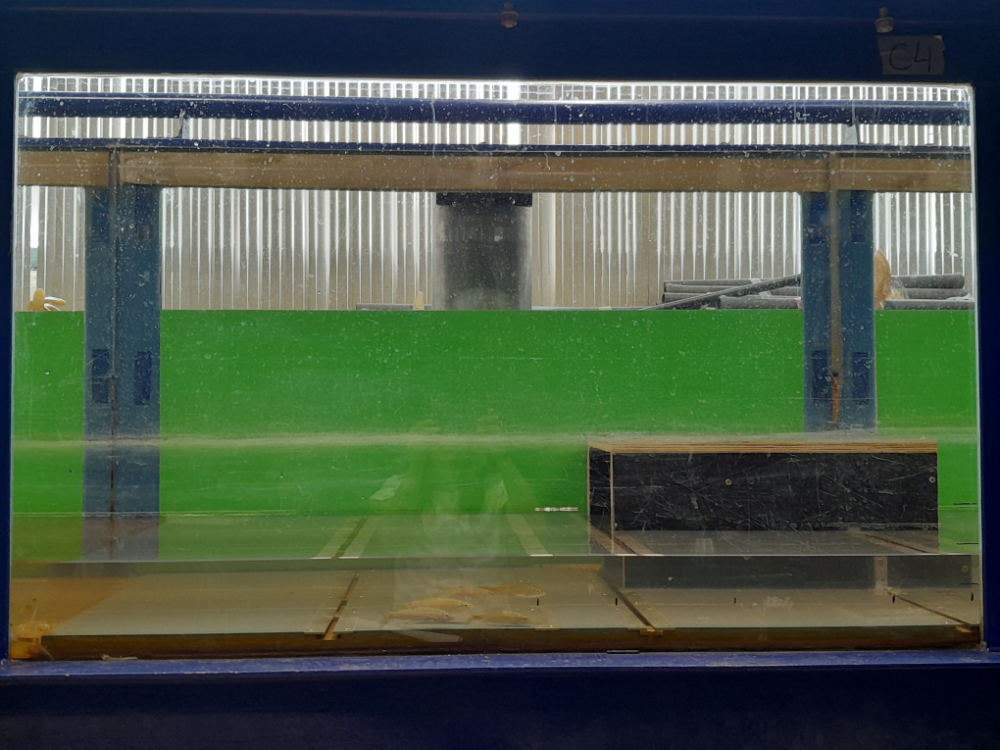


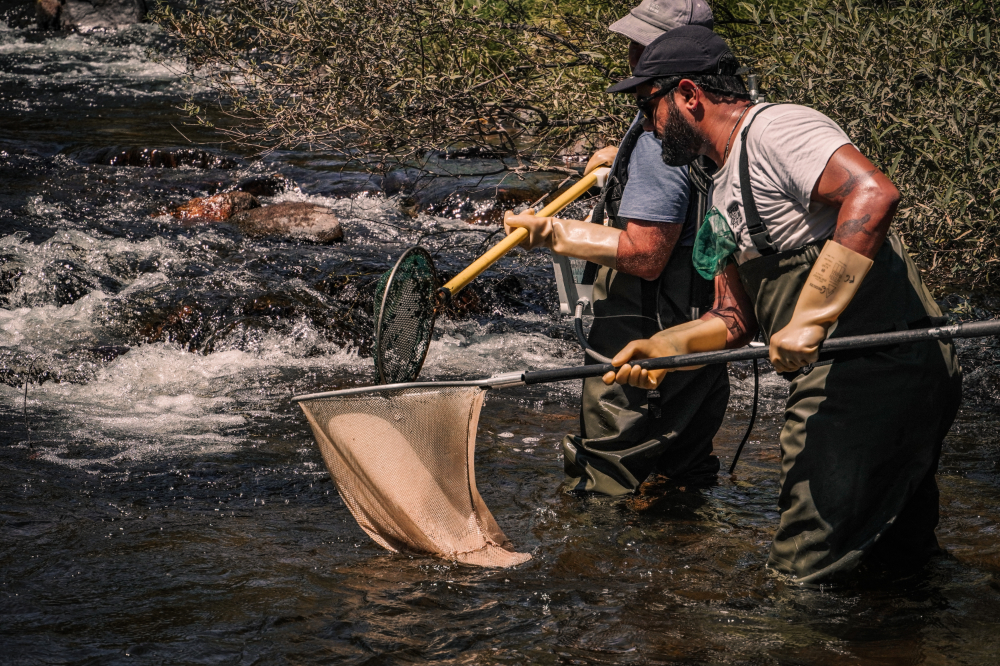
Renan Leite talks about his experience as a PhD candidate within EcoPeak4Fish
Renan Leite collaborates with EcoPeak4Fish as a very motivated PhD candidate. He started at the beginning of the project and his PhD is almost completed. Renan is passionate about conservation biology and soon he realized that the aquatic system was that which he wanted to explore. With an MSc in Management and Conservation of Natural Resources from the University of Évora, his research focused on the study of the migratory behaviour of the trout. Renan remembers his work at MARE “I spent endless hours, counting hundreds of trouts that were using a vertical slot fishway in the Mondego River. This was challenging, but I also learned so much about lampreys, barbels, and various other fish species over the many research projects I collaborated with”. Renan knew he wanted to pursue a research career, “I remember perfectly when a senior scientist advised me to apply to the FLUVIO PhD programme. I hadn’t considered it until that time, so it was like an Eureka moment!”, he laughs. He remembers the day he got the positive email and how he got excited to be again “connected with the conservation of natural resources”, he affirms.
Renan participation in EcoPeak4Fish has been wholesome. Whenever the tasks involve fieldwork, he is the first to volunteer. “Well, I am passionate about nature and fieldwork, and the diverse methods we can use to fully understand how nature works”, he says. During his PhD odyssey in the EcoPeak4Fish project, Renan participated in several conferences and a training course in Romania. “I believe that cultural differences make us thrive in so many ways, both personal and professional. Since my journey in science began, I embraced many experiences convergent with nature conservation; I’ve been an Environmental educator in Peru, and an organic farmer in Luxembourg”, he recalls.
Now that this journey is at its final, can he write a couple of words about his PhD experience and his participation in this project? Yes, “People say that PhD time is a solitary period, but I disagree. This has been an amazing time for me. From my trips, fieldwork, lab work, and even desk work, I have been in contact with so many inspiring people and learned so much more than I ever thought. I would even dare to say that I would do it all again!”
Good luck with all your future endeavours, Renan!




Have you had a chance to explore our latest infosheet?
As part of our ongoing project, we have been releasing informative sheets containing details about various project aspects and outputs from different tasks. These infosheets meticulously present high-quality information in a structured and comprehensive manner, addressing specific issues, problems, and topics.
Written in a clear and accessible style, we have made a conscious effort to avoid complex scientific and technological terms, ensuring that our content is understandable to a wider audience. Our newest infosheet covers the insights gained from our laboratory work conducted in the indoor flume at Instituto Superior Técnico where we assessed the effectiveness of flow-refuges.
We invite you to take a brief 2-minute look here! Your invested time will provide you with valuable insights into our project's progress and findings.
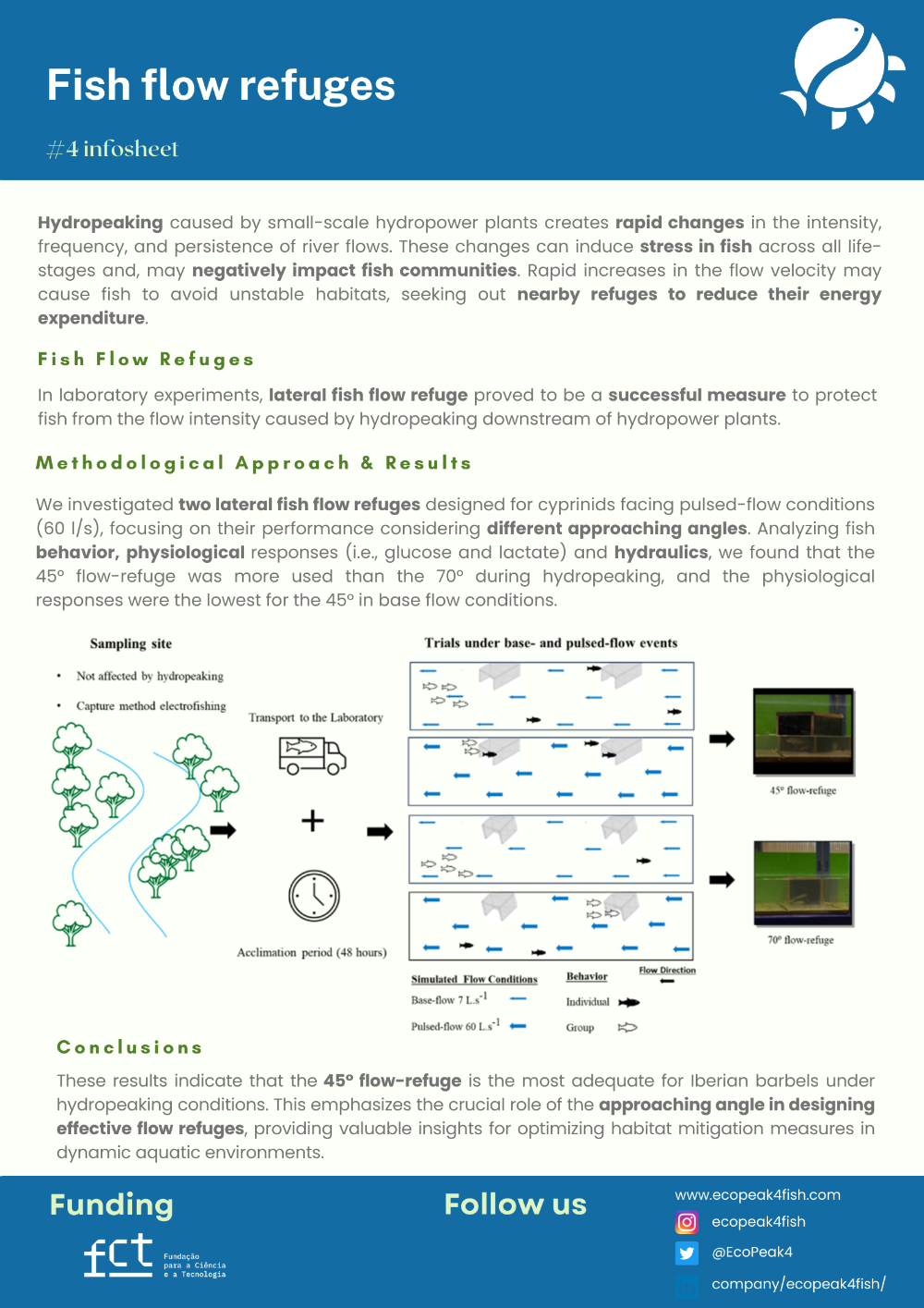

Save the date!
The closing session of EcoPeak4Fish will be held on the 02nd of April 2024 at Instituto Superior Técnico, University of Lisbon. This event will take place in the sunny city of Lisbon. The participants are invited to this closing session and learn with the EcoPeak4Fish team about the major project outputs, from the method of installing a flow refuge as a mitigation measure to hydropeaking to the framework that promotes fish habitat protection while assuring sustainable hydropower production. The session will bring together interested stakeholders, from hydropower producers to the general public, and will include a visit to the hydraulic laboratory and presentations from the team members and from our Norwegian colleagues of the SHAREe project, to share their vision and experience of hydropower production in Norway.
The event will be in English. We will prepare an online session so that the project followers don’t miss a thing! In case you are curious about this local meeting and its communications, don't hesitate to contact us!


 The EcoPeak4Fish team wishes you a wonderful Christmas and a new year full of joy, success and care for our freshwater ecosystems!
The EcoPeak4Fish team wishes you a wonderful Christmas and a new year full of joy, success and care for our freshwater ecosystems!



